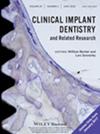Reconstructive Therapy of Peri-Implantitis Following Non-Surgical Treatment: A Randomized Controlled Trial
Abstract
Aim
To evaluate the clinical and radiographic outcomes of non-surgical treatment followed by either reconstructive therapy or supportive care with no further surgical measures for the treatment of peri-implantitis intra-bony defects.
Materials and Methods
This randomized clinical trial included patients diagnosed with peri-implantitis exhibiting intrabony defects (≥ 3 mm). All 36 patients received a standardized peri-implant non-surgical therapy. Patients who did not demonstrate disease resolution based on clinical and radiographic re-evaluation were randomized into two groups. The test group received reconstructive therapy [reconstructive group (RG)] while the control group received no additional treatment except supportive care every 3 months [non-reconstructive group (NRG)]. The primary outcome was the mean radiographic bone change at 12 months; the difference between groups was assessed using Mann–Whitney two-sample tests. Clinical and radiographic parameters were recorded at the initial examination and at 3, 6, and 12 months. Also, patient-reported outcomes were assessed.
Results
Overall, 34 patients (implants = 34) completed the study. Both therapies resulted in significant clinical and radiographic changes after 12 months. Disease resolution was achieved in 8 (44.4%) NRG patients and 7 (43.8%) RG patients (p ≥ 0.05) with no significant differences between groups. The groups displayed no significant differences in clinical variables, but radiographic bone fill was ~3× greater in the RG group at 12 months [1.21 (SD 0.92) mm versus 0.36 (SD 0.59) mm], demonstrating statistical significance between the tested groups.
Conclusions
The tested therapeutic modalities demonstrated equal disease resolution. Nevertheless, the marginal bone level gain was significantly greater for sites subjected to reconstructive surgical therapy (NCT05168891—This clinical trial was not registered prior to participant recruitment and randomization).

 求助内容:
求助内容: 应助结果提醒方式:
应助结果提醒方式:


